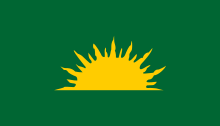Goidels

An Gal Gréine, a traditional Gaelic symbol first mentioned in the Fiannaíocht.
|
|
| Total population | |
|---|---|
| c. 1.9 million (linguistic) | |
| Regions with significant populations | |
|
|
1,770,000 (linguistic) |
|
|
122,518 (linguistic) |
|
|
27,475 (linguistic) |
|
|
9,000 (linguistic) |
|
|
2,717 (linguistic) |
|
|
670 (linguistic) |
| Languages | |
|
Irish · Scottish Gaelic · Manx (Non-Gaelic: English · Scots) |
|
| Religion | |
| Christianity · Irreligion (historic: Paganism) | |
| Related ethnic groups | |
| Norse-Gaels · Gaelicised Normans | |
The Gaels (Irish pronunciation: [ɡeːlˠ], Scottish Gaelic pronunciation: [kɛː.əlˠ]; Irish: Na Gaeil, Scottish Gaelic: Na Gàidheil) are an ethnolinguistic group native to northwestern Europe. They are associated with the Gaelic languages: a branch of the Celtic languages comprising Irish, Manx and Scottish Gaelic. Historically, the ethnonyms Irish and Scots referred to the Gaels in general, but the scope of those nationalities is today more complex.
Gaelic language and culture originated in Ireland, extending to Dál Riata in western Scotland. In antiquity the Gaels traded with the Roman Empire and also raided Roman Britain. In the Middle Ages, Gaelic culture became dominant throughout the rest of Scotland and the Isle of Man. There was also some Gaelic settlement in Wales and Cornwall. In the Viking Age, small numbers of Vikings raided and settled in Gaelic lands, becoming the Norse-Gaels. In the 9th century, Dál Riata and Pictland merged to form the Gaelic Kingdom of Alba. Meanwhile, Gaelic Ireland was made up of several kingdoms, with a High King often claiming lordship over them.
...
Wikipedia
